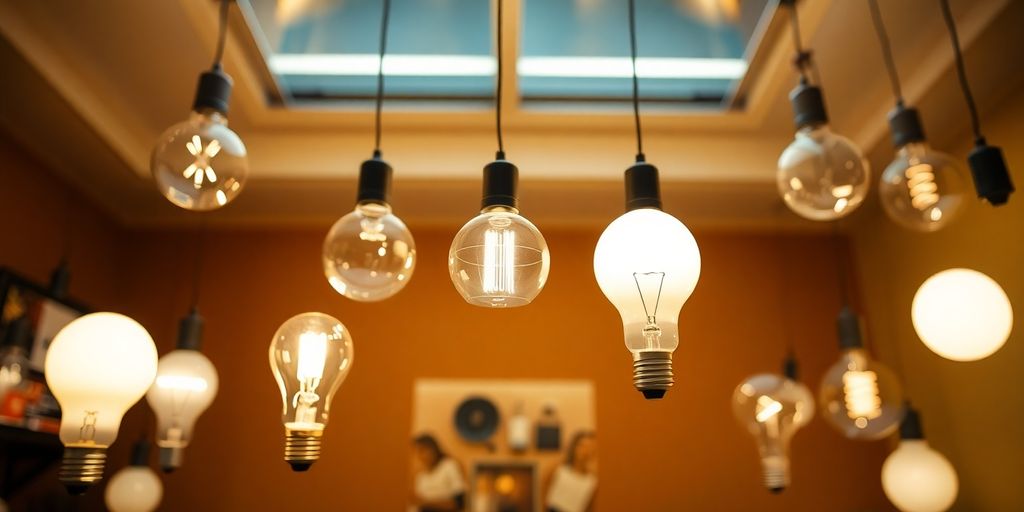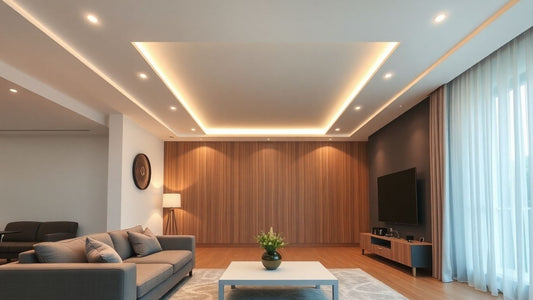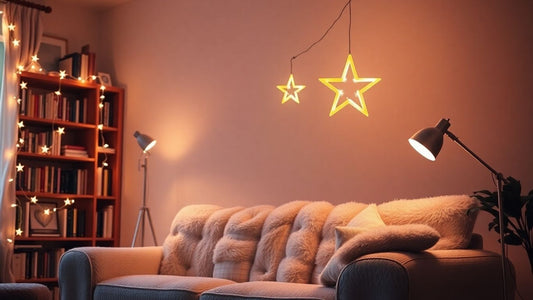Choosing the Right Bright Bulb: A Guide to the Brightest Options for Your Home
Picking the right bright bulb for your home can be a bit like solving a puzzle. With so many choices out there, from LEDs to halogens, it's easy to feel overwhelmed. But don't worry, this guide is here to help you figure out what you need to light up your space just right. Whether you're looking for energy savings or the perfect ambiance, understanding the basics will make your decision a whole lot easier.
Key Takeaways
- Lumens, not watts, measure brightness. Higher lumens mean brighter light.
- LEDs are the most energy-efficient and long-lasting bulbs available.
- Colour temperature affects the mood; warm white is cosy, cool white is bright.
- Different rooms need different lighting; living rooms need softer light, kitchens need brighter light.
- Consider bulb shape and fitting for compatibility with your fixtures.
Understanding Light Bulb Brightness
Lumens vs Watts: What You Need to Know
Once upon a time, we judged a bulb's brightness by its wattage. But wattage only tells you how much power a bulb uses, not how bright it is. Nowadays, we use lumens to measure brightness. Lumens indicate the total amount of visible light emitted by a source. The higher the lumens, the brighter the bulb. For instance, a 60-watt incandescent bulb gives off about 800 lumens, whereas an energy-efficient LED might use just 10 watts to produce the same brightness.
How to Compare Brightness Levels
When you're picking out bulbs, it's all about finding the right brightness for the space. Here's a quick guide:
- Living Rooms & Bedrooms: Aim for 800-1,100 lumens for a warm, inviting glow.
- Kitchens & Bathrooms: These need brighter lighting, around 1,000-1,500 lumens, for tasks like cooking and grooming.
- Garages & Offices: Go for 1,600-2,500 lumens for clear, focused light.
Common Lumen Outputs for Home Lighting
Understanding how lumens translate to everyday use can help you pick the right bulb for each room. For example, a bedside lamp might only need a bulb with 400 lumens, while a kitchen ceiling light could require one with 1,500 lumens.
As you shop for bulbs, remember that G9 LED Lamp Sets offer customizable options to fit your lighting needs. Whether you're after a soft glow or a bright spotlight, there's a bulb out there for you.
Exploring LED Light Bulbs
Advantages of LED Bulbs
LED bulbs are like the rockstars of the lighting world. They might cost a bit more upfront, but they save you money in the long run. They use about 90% less energy than those old-school incandescent bulbs, and they can last for ages, sometimes up to 30 years! That's a lot of savings on your energy bill. Plus, they don't get hot like the other bulbs, which makes them safer to use, especially if you've got little ones around.
Brightest LED Bulbs for Home Use
When you're looking for the brightest LED bulbs, you want to focus on lumens, not watts. Lumens tell you how bright the bulb is. For a living room, you might want a bulb with around 800 lumens, which is like a 60W incandescent bulb. But if you're lighting up a workspace, go for something brighter, like 1500 lumens or more. Explore a variety of LED corn light bulbs if you need something super bright for large spaces.
Energy Efficiency and Longevity of LEDs
LEDs are the MVPs when it comes to energy efficiency. They last way longer than other types of bulbs, like CFLs or halogens. We're talking up to 50,000 hours of light, which is like 25 years if you use them a few hours every day. And because they use less energy, they're kinder to the planet too. If you're thinking about replacing your bulbs, going with LEDs is a no-brainer for saving money and energy.
The Role of Colour Temperature in Lighting
Warm White vs Cool White: Choosing the Right Tone
Choosing the right colour temperature for your bulbs makes a huge difference in how your space feels. Warm white bulbs, typically ranging from 2700K to 3000K, cast a cosy, inviting glow. They're perfect for living rooms and bedrooms where you want to relax. On the other hand, cool white bulbs, with a Kelvin range between 3500K and 4100K, are ideal for kitchens and bathrooms. They provide a bright, clean light that's great for tasks.
Daylight Bulbs: When to Use Them
Daylight bulbs, ranging from 5000K to 6500K, mimic natural daylight. These are fantastic for areas where you need high visibility, like garages, reading areas, or workspaces. They can also be beneficial in places where you want to reduce eye strain by providing a clearer view of colours.
Before choosing a bulb, think about the mood you want to create in each room. The right colour temperature can transform your space, making it more functional or relaxing.
Impact of Colour Temperature on Ambiance
Colour temperature isn't just about brightness; it's about setting the mood. A warm white bulb can make a room feel snug and intimate, while a cool white bulb can make it feel spacious and energising. When selecting bulbs, consider how the room is used and the atmosphere you want to create. For a versatile option, consider a Dimmable RGB Smart Bulb that allows you to adjust both brightness and colour to suit your mood.
Comparing Different Bulb Technologies
LEDs vs CFLs: Which is Better?
When it comes to lighting your home, the choice between LED and CFL bulbs can be a bit of a head-scratcher. LEDs, or Light Emitting Diodes, are the frontrunners in energy efficiency. They use up to 90% less energy than traditional incandescent bulbs and about 50% less than CFLs. This means lower electricity bills and a smaller carbon footprint. Plus, LEDs have a long lifespan, often lasting between 15,000 to 50,000 hours, which is significantly longer than CFLs. On the downside, LEDs can be pricier upfront, but they pay off in the long run with their durability and energy savings.
CFLs, or Compact Fluorescent Lamps, are a bit cheaper to buy initially. They are more energy-efficient than incandescent bulbs but not as much as LEDs. CFLs contain a small amount of mercury, which requires careful disposal. They also take a moment to warm up to full brightness, which can be a minor inconvenience.
| Feature | LED Bulbs | CFL Bulbs |
|---|---|---|
| Energy Usage | Very low | Moderate |
| Lifespan | 15,000-50,000 hours | 8,000-15,000 hours |
| Cost | High upfront | Lower upfront |
| Brightness | Instant | Delayed |
| Disposal | Easy | Requires care |
Halogen Bulbs: Pros and Cons
Halogen bulbs are a type of incandescent bulb that are slightly more efficient than traditional incandescents. They emit a bright, white light and reach full brightness instantly. However, they have a shorter lifespan compared to LEDs and CFLs, typically lasting about 2,000 hours. Halogens are also less energy-efficient, using more power and generating more heat. This makes them less ideal for energy-conscious homeowners.
- Pros of Halogen Bulbs:
- Cons of Halogen Bulbs:
Why Incandescent Bulbs Are Becoming Obsolete
Incandescent bulbs, once the go-to for household lighting, are quickly fading into the past. They work by heating a filament until it glows, which is a very inefficient process. Incandescents convert only about 10% of the energy they use into light, with the rest lost as heat. This inefficiency, coupled with their short lifespan of about 1,000 hours, makes them costly and environmentally unfriendly.
As energy efficiency becomes more important, many countries have phased out or restricted the sale of incandescent bulbs. This shift encourages consumers to opt for more sustainable lighting options like LEDs or CFLs.
For those looking to explore a selection of new home light bulbs, there are plenty of options that offer better efficiency and longer lifespans, making them a smarter choice for both your wallet and the planet.
Choosing the Right Bulb for Each Room

Living Rooms and Bedrooms: Creating a Cosy Atmosphere
In living rooms and bedrooms, comfort is key. You want a warm and inviting glow, perfect for winding down after a long day. Consider using bulbs with a colour temperature between 2700K and 3000K. These "warm white" lights create a relaxing ambience. Opt for dimmable options to adjust the brightness according to the time of day or mood. A bulb with a brightness of about 800 lumens is ideal for these spaces, providing enough light to read by without being too harsh.
Kitchens and Bathrooms: Need for Bright, Focused Lighting
Kitchens and bathrooms require bright, focused lighting to perform tasks efficiently. Choose bulbs with a "cool white" colour temperature, ranging from 3500K to 4100K. This ensures a clean and crisp light, enhancing visibility. Aim for bulbs with higher lumens, around 1000 to 1500, to adequately illuminate these busy areas. Consider using adjustable LED bulbs for customisable lighting solutions in these functional spaces.
Workspaces and Garages: High-Intensity Lighting Needs
For workspaces and garages, where precision and clarity are essential, opt for "daylight" bulbs with a colour temperature between 5000K and 6500K. These bulbs mimic natural daylight, reducing eye strain and improving concentration. A high lumen output, typically 1500 lumens or more, ensures the space is well-lit for any task. Remote-controlled or smart bulbs can be particularly useful here, allowing you to adjust settings without interrupting your work.
Selecting the right bulb for each room involves balancing the light's warmth and brightness with the room's function. Whether you're creating a cosy retreat or a bright workspace, the right lighting can transform your home.
Energy Efficiency and Cost Considerations

Long-Term Savings with Energy-Efficient Bulbs
Energy-efficient bulbs, like LEDs and CFLs, might seem more expensive upfront, but they offer significant savings over time. LED bulbs use up to 90% less energy than traditional incandescent bulbs, which means lower electricity bills. CFLs are not far behind, using about 60-80% less energy. This efficiency translates into savings that can add up over the years, especially if you're replacing multiple bulbs throughout your home.
Balancing Upfront Costs with Longevity
While LEDs and CFLs come with a higher price tag initially, their longevity makes them a smart investment. A typical incandescent bulb might last around 1,000 hours, whereas a CFL can last up to 15,000 hours, and an LED can shine bright for up to 50,000 hours. So, although you pay more at the checkout, you won't be buying replacements as often. This means fewer trips to the store and less hassle changing bulbs.
Environmental Impact of Different Bulb Types
Choosing energy-efficient bulbs isn't just good for your wallet—it's better for the planet too. By using less electricity, LED and CFL bulbs reduce your carbon footprint. Plus, they don't contain harmful substances like mercury, which is a concern with some other bulb types. As more people make the switch to efficient lighting, the cumulative effect can lead to significant environmental benefits.
Opting for energy-efficient lighting is a win-win: it saves you money and helps protect the environment. It's a simple change that can make a big difference over time. If you're looking for a range of light bulbs to fit your needs, consider exploring options like LEDs and CFLs, which offer both efficiency and longevity.
Understanding Bulb Shapes and Fittings
When it comes to lighting up your home, choosing the right bulb shape and fitting is just as important as selecting the correct brightness. The shape of your bulb can significantly impact the spread and quality of light in a room. Let's dive into the most common shapes and fittings you'll encounter.
Common Bulb Shapes for Home Use
- GLS (General Light Service) Bulbs: This is your classic bulb shape, perfect for a wide range of fixtures, from lamps to ceiling lights. It provides an even, all-around light.
- Candle Bulbs: Resembling the flame of a candle, these bulbs are ideal for chandeliers and decorative fixtures where the bulb is visible.
- Globe Bulbs: Large and round, globe bulbs are often used in decorative fixtures. They offer a 360-degree light spread, making them great for ambient lighting.
- Spotlight Bulbs: Also known as PAR bulbs, these are designed to focus light on a specific area, making them perfect for task lighting in kitchens or bathrooms.
- Tube Bulbs: Often used in under-cabinet lighting or office settings, tube bulbs provide a broad spread of light.
How to Identify Your Bulb Fitting
Identifying the correct bulb fitting is crucial to ensure compatibility with your light fixture. Here are some common types:
- B22 (Bayonet Cap): Found in many standard overhead fittings.
- E27 (Edison Screw): A popular choice for many lamps and ceiling fixtures.
- E14 (Small Edison Screw): Typically used in smaller lamps.
- GU10: Common in spotlights and recessed lighting.
If you're unsure about your fitting, check the base of your old bulb or the packaging for guidance.
Using Cap Converters for Compatibility
Sometimes, you might find the perfect bulb, but it doesn't fit your fixture. That's where cap converters come in handy. These nifty devices allow you to use a bulb with a different fitting, like an E27 bulb in a B22 fitting. They're a simple solution to expand your bulb options without changing your light fixture.
Choosing the right bulb shape and fitting can transform your space, enhancing both functionality and style. Whether you're after a cosy glow or focused task lighting, understanding these basics will help you make the best choice for your home.
When it comes to light bulbs, understanding the different shapes and fittings is key. Each type of bulb has a specific design that fits into various light fixtures. For example, some bulbs are round, while others are more elongated. Knowing which bulb fits where can help you choose the right one for your needs. If you're looking for the perfect bulb, visit our website for a wide selection and free shipping on all orders!
Wrapping It Up: Your Brightest Choice Awaits
So there you have it, folks. Picking the right bulb isn't just about lighting up a room; it's about setting the mood, saving on those pesky energy bills, and maybe even doing a bit for the planet. LEDs are the top dogs in brightness and efficiency, but don't count out those halogens and CFLs if they suit your style. Remember, it's all about what works best for your space and your needs. Whether you're after a warm glow for the living room or a bright light for the kitchen, there's a bulb out there with your name on it. Happy shopping, and may your home be ever bright!
Frequently Asked Questions
What is the difference between lumens and watts?
Lumens measure how bright a light bulb is, while watts measure how much energy it uses. In the past, people used watts to guess brightness, but now lumens are a better way to know how bright a bulb will be.
How do I choose the right brightness for each room?
For cosy areas like living rooms, 800 to 1,100 lumens is good. Kitchens and bathrooms need brighter light, around 1,000 to 1,500 lumens. Workspaces and garages might need even more, from 1,600 to 2,500 lumens.
Why are LED bulbs a popular choice?
LED bulbs are popular because they use less energy and last a long time. They can be very bright and turn on instantly. They save money on electricity bills over time.
What is colour temperature, and why does it matter?
Colour temperature tells you if the light is warm or cool. Warm lights (2,700K to 3,000K) are cosy, while cool lights (3,500K to 6,500K) are better for tasks. It helps set the mood in a room.
Are incandescent bulbs still a good option?
Incandescent bulbs are not as energy-efficient as LEDs or CFLs and have a shorter lifespan. They give a warm light but use more energy, so many people prefer other types now.
Can I use a different shaped bulb in my light fixture?
Yes, but you need to make sure it fits. Some fixtures need specific shapes, like spotlights or chandeliers. You can also use cap converters to fit different bulb bases.



